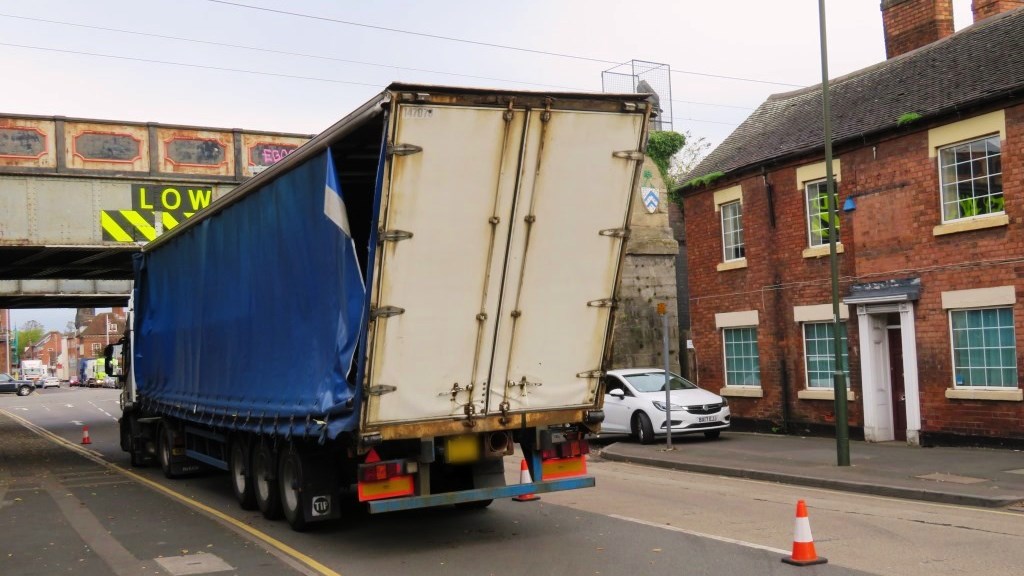Friday 3 Jul 2020
Lorry drivers urged to follow correct A5 diversions to avoid Britain’s most bashed railway bridge
- Region & Route:
- North West & Central
- | North West & Central: Central
Drivers are being urged to follow in full A5 diversions around Lichfield next week to avoid hitting Britain’s most bashed railway bridge.
It’s feared major roadworks on the A5 near Lichfield could see drivers of high vehicles try to take a shortcut, or follow inaccurate sat-nav directions, directly into the path of St John Street bridge in the city.
Despite being clearly marked with height restrictions, the bridge has been hit 28 times in the last 12 months, making it Network Rail’s most struck.
Bridge strikes cause delays for rail passengers across the country and cost taxpayers millions of pounds each year.
With roadworks starting on the A5 on Monday (6 July), Network Rail is advising motorists to follow Highway England’s diversionary routes which avoid the low railway bridge near Lichfield City station.
Martin Colmey, head of operations for Central route, said: “With St John Street bridge in Lichfield already having the unenviable title of the most bashed in the country, I’d urge all drivers of large vehicles to follow the recommended diversion signs and not their sat-nav during Highways England’s work on the A5.
“There is no excuse for drivers to hit railway bridges. Bridge strikes are entirely avoidable, put the safety of rail passengers and road users at risk, and cost the taxpayer millions of pounds each year to fix. Our message is simple - lorry drivers, plan your route and know, don’t guess, the height of your vehicle.”
Resurfacing work is being carried out at Wall roundabout on the A5, between Muckley Corner and the Weeford roundabout, from 6 to 24 July.
The road will be closed in both directions, between the A46 and M6 junction 2, from 8pm to 6am every weeknight.
Motorists driving high sided vehicles should follow the signed diversion routes, agreed with the local authority, to avoid the Lichfield bridge.
A Lichfield local has set up a Twitter account for St John Street bridge (@LichfieldBridge) because it has been hit so many times.
Drivers are being urged to plan ahead by reviewing then following these diversionary routes.
Notes to Editors
Bridge strikes cause delays for rail passengers across the country and cost taxpayers millions of pounds each year.
This public money could be used to improve accessibility, reliability and comfort for passengers.
In the last year:
- There were almost 2,000 instances of vehicles hitting railway bridges – an average of five per day
- It cost Network Rail £16 million in schedule 8 (delay) payments
- Bridge strikes caused more than 200,000 minutes of delays for rail passengers.
On average nationally, each strike caused 90 minutes of delays and cost £7,000.
Research carried out by Network Rail has shown that 52 per cent of lorry drivers do not take low bridges into account when planning their route, and 43 per cent admitted they did not measure their vehicle before heading out on the road.
Network Rail is aiming to improve education amongst professional HGV drivers as well as engaging with their employers and the general public, to try to reduce bridge strikes by 10%.
We work with companies like the Road Haulage Association, Wincanton, Highways England, the DVSA and other bodies to tackle this issue.
Contact information
Passengers / community members
Network Rail national helpline
03457 11 41 41
Latest travel advice
Please visit National Rail Enquiries
Journalists
Network Rail press office - North West & Central Region
0330 854 0100
NWCmediarelations@networkrail.co.uk
About Network Rail
We own, operate and develop Britain's railway infrastructure; that's 20,000 miles of track, 30,000 bridges, tunnels and viaducts and the thousands of signals, level crossings and stations. We run 20 of the UK's largest stations while all the others, over 2,500, are run by the country's train operating companies.
Usually, there are almost five million journeys made in the UK and over 600 freight trains run on the network. People depend on Britain's railway for their daily commute, to visit friends and loved ones and to get them home safe every day. Our role is to deliver a safe and reliable railway, so we carefully manage and deliver thousands of projects every year that form part of the multi-billion pound Railway Upgrade Plan, to grow and expand the nation's railway network to respond to the tremendous growth and demand the railway has experienced - a doubling of passenger journeys over the past 20 years.
Follow us on Twitter: @networkrail
Visit our online newsroom: www.networkrailmediacentre.co.uk



